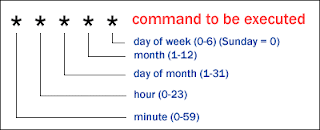What is Crontab?
Crontab (CRON TABle)is a program that manipulates the CRON daemon, making it easy for
users to schedule task and run programs/commands at pre determined
periods of time. Crontab can also be considered a file witch contains
commands that will be run by the system as the user that owns the
crontab file.
What is the purpose of Crontab?
Cron is designed to maintain a list of commands that the system
needs to run at a given time interval.
For example if you have a
script that generates statistics and needs to be run every couple of
hours or everyday cron can do it for you. Or for example if you have
a script that sends a newsletter every month you can use cron to run
the script that sends the newsletter every month or week.
Crontab commands
When your logged
in to your server you can use program cron using the following
commands:
-
crontab -l
Lists the current cron jobs -
crontab -e
Edit your current crontab file and ad/remove/edit crontab tasks. -
crontab -r
Remove the crontab file. -
crontab -v
Displays the last time you edited your crontab file.
The crontab file – components of crontab
When you enter the edit mode (crontab -e) and start adding
tasks to your cron file you need to consider the following syntax:
 |
| Cron Structure |
The asterisk (*) symbolizes that every instance of that field (i.e.
every minute, hour, day, month, weekday) will be used in the command.
Example on how to setup your first crontab
Lets say you have a script named run-me.sh located in
/home/your_username you want to run every day at 13:30.
You will need to login your server console and input the following
commands:
-
crontab
-e
This will open the crontab file and let you edit it. By default this file will be opened with the VI editor and you will need to press the “Insert” key on your keyboard to be able to write in that file. -
30
13 * * * /home/your_username/run-me.sh >/dev/null
2>&1
The first character you see is “30” this means that crontab will run the script every time the clock hits the 30 minutes mark. Next “13” this means that crontab will run the script when the clock hits 13. The next three * tell crontab to run the script every day, of every month of every weekday. Combining these fields crontab will run the script every day at exactly 13:30. You may notice that we added the “>/dev/null 2>&1” string at the end of the command. The default cron job will always send and e-mail to the root account when ever a command is executed. Now you don't want to be notified every day that your crontab job has been executed. If you don't want to receive e-mails every day notifying you about your job's execution place this “>/dev/null 2>&1” at the end of every instance of every crontab command.
When you are finished
adding your commands to the crontab file you need to save and exit.
If you are using VI as your editor you need to issue the following
commands:
- Press the Esc (Escape key) on your keyboard to enter the command mode of VI
- After you pressed Escape then type the following characters :wq! and press Enter. Remember you have to type this characters (remove the quotes): “:wq!”.
Now to list your crontab job just issue the following command: crontab -l
If
you need to ad another crontab job or even more all you need to do is
follow the same steps as above and just ad another line to the
file.
REMEMBER: Every crontab job needs to be placed on its own line in the file and after the last line you need to insert a non-braking character (press Enter).
REMEMBER: Every crontab job needs to be placed on its own line in the file and after the last line you need to insert a non-braking character (press Enter).
The
crontab syntax goes a little beyond its boundaries and has more
advance meaning for some users.
For example if you wish to use more then one instance of one column you will separate those instances by a comma “,” or if you wish to use a time period lets say for example from Sunday till Tuesday you will use dash “-”.
For example if you wish to use more then one instance of one column you will separate those instances by a comma “,” or if you wish to use a time period lets say for example from Sunday till Tuesday you will use dash “-”.
10,20,30 13 * * 0-2 /home/your_username/run-me.sh >/dev/null 2>&1
This
crontab job will run your scrip “run-me.sh”
on from Sunday
until Tuesday13:10,
13:20 and 13:30. Remember
there are no
spaces between values separated by commas
“,”
and
neither in dashes
“-”. There
is also an operator that some versions of cron support called the
slash operator “/” that
can be used to skip a given number of values in your jobs.
(Sunday, Monday, Tuesday) at
Crontab examples - cron examples
The
syntax of crontab is not very easy to understand from the start and
the best way of understanding is from examples:
Run the script every day at 12:00.
0
12 * * * /home/your_username/run-me.sh
>/dev/null
2>&1
Run the script every day at 12:00, 14:00 and 16:00.
0
12,14,16 * * * /home/your_username/run-me.sh
>/dev/null
2>&1
Run the script every Sunday at 13:30.
30
13 * * 0 /home/your_username/run-me.sh
>/dev/null
2>&1
Run the script every Saturday at 12:00, 14:00 and 16:00.
0
12,14,16 * * 6 /home/your_username/run-me.sh
>/dev/null
2>&1
Run the script on the first, fifteenth and twentieth of every month.
0 0 1,15,20 * * /home/your_username/run-me.sh >/dev/null 2>&1
Run the script every day from 3 to 3 hours: 00:00, 03:00, 06:00 etc.
0
*/3 * * * /home/your_username/run-me.sh
>/dev/null
2>&1
Original: http://www.tutorial5.com/content/view/95/51/
No comments:
Post a Comment